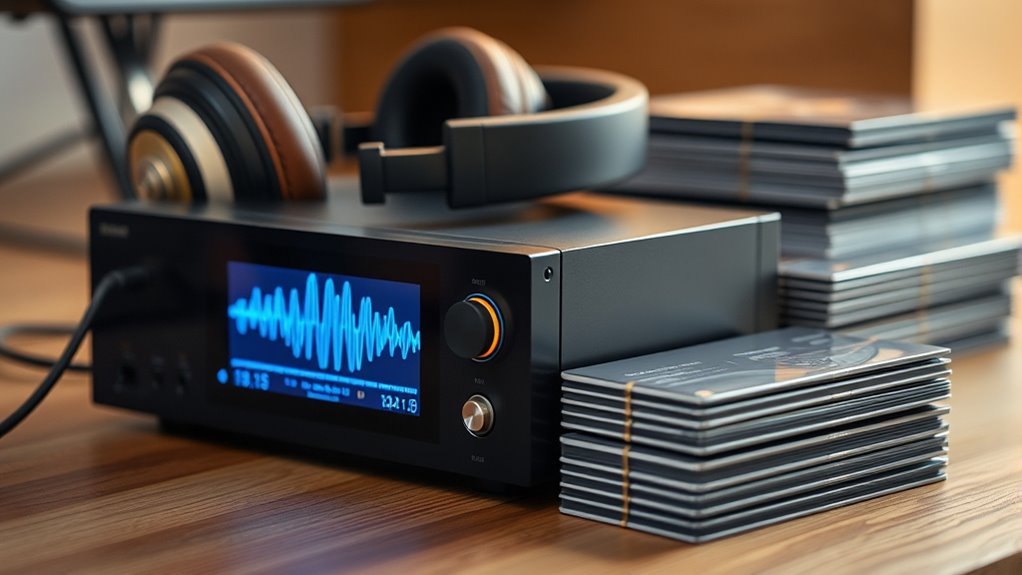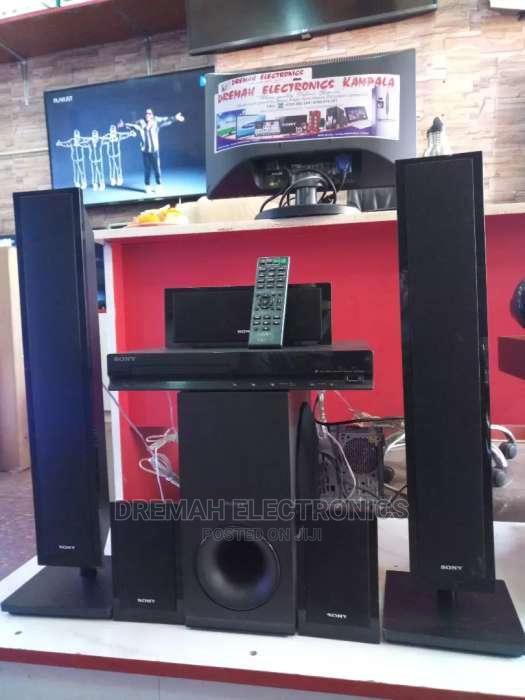High-resolution audio and lossless formats let you enjoy music closer to the original recordings with more detail and clarity. High-res audio uses higher sample rates and bit depths, capturing nuances that compressed formats lose. Lossless formats like FLAC and ALAC preserve all this extra data without compression, offering a richer, more authentic sound experience. If you explore further, you’ll discover how these technologies elevate your listening to a new level.
Key Takeaways
- High-resolution audio offers more detailed sound by using higher sample rates and bit depths than standard formats.
- Lossless formats like FLAC and ALAC preserve all original data, ensuring authentic, uncompressed sound quality.
- Higher bit depth increases dynamic range, capturing softer and louder sounds more accurately.
- Elevated sample rates improve reproduction of high-frequency sounds, enhancing clarity and nuance.
- Combining high bit depth, sample rate, and lossless compression provides a richer, more lifelike listening experience.

Have you ever wondered if there’s a way to experience music that sounds closer to the original recording? High-resolution audio aims to do just that, offering a more detailed and authentic listening experience. To understand how it works, you need to grasp two key concepts: bit depth and sample rate. These technical specifications determine the quality of digital audio and how accurately it reproduces sound.
Bit depth refers to the amount of information stored for each audio sample. Think of it as the resolution of your sound, similar to how pixels define the clarity of a picture. Higher bit depth means more data per sample, which translates into a greater dynamic range—the difference between the softest and loudest sounds. For example, CD quality audio uses 16-bit depth, providing a dynamic range of about 96 decibels. In contrast, high-resolution audio often uses 24-bit depth, increasing the dynamic range to approximately 144 decibels. This extra depth captures subtler nuances and quieter details, making your listening experience richer and more lifelike.
Higher bit depth captures subtler nuances, making your listening experience richer and more lifelike.
Sample rate, on the other hand, is how frequently audio samples are taken per second. It’s measured in hertz (Hz). A higher sample rate allows the audio to more accurately reproduce higher frequencies, which are essential for clarity and detail. Standard CDs operate at a sample rate of 44.1 kHz, meaning 44,100 samples are taken each second. High-resolution formats, however, often utilize sample rates like 96 kHz or even 192 kHz. This higher sampling rate ensures the audio can capture a broader spectrum of sound, especially the high-frequency components that add brightness and detail to music.
Additionally, the use of lossless formats such as FLAC or ALAC preserves all of this high-resolution data without compression, ensuring an unaltered listening experience. When you combine a high bit depth with a high sample rate, you get a digital representation that’s remarkably close to the original analog recording. This means you’ll notice greater clarity, more precise instrument separation, and a fuller soundstage. lossless formats, such as FLAC or ALAC, preserve this high-resolution data without compression, ensuring that what you hear is exactly what was recorded. Unlike compressed formats like MP3, lossless files retain all the original detail, allowing you to enjoy music as the artist and producer intended.
In essence, understanding bit depth and sample rate helps you appreciate what high-resolution audio offers. It’s about capturing more detail, more nuance, and delivering a listening experience that’s closer to live music or the original studio recording. If you’re enthusiastic to experience music in its purest form, choosing formats with higher bit depth and sample rates, stored in lossless formats, is the way to go.
Frequently Asked Questions
How Do High-Resolution Audio Files Impact Storage Space?
High-resolution audio files take up more storage space due to their larger file sizes, influenced by lower compression efficiency. Since they retain more audio detail, they don’t compress as effectively as standard formats, leading to bigger file size implications. You’ll need more storage capacity to keep high-res files, but you get better sound quality. Be prepared to manage your storage or consider compression options to balance quality and space.
Can I Hear the Difference Between Lossless and Lossy Formats?
You can hear the difference between lossless and lossy formats, especially when you compare bit depth and frequency response. Lossless files preserve more detail, offering a richer, more accurate sound. Imagine listening to music with clearer vocals and deeper bass—stuff that lossy formats might smooth over or cut out. If your equipment is good, you’ll notice the subtle nuances and wider dynamic range, making the experience much more immersive.
What Equipment Is Necessary to Enjoy High-Resolution Audio?
To enjoy high-resolution audio, you need quality headphone equipment and a good digital-to-analog converter (DAC). Invest in headphones with high fidelity and wide frequency response to capture detail. A dedicated DAC improves sound clarity by accurately converting digital signals to analog. Confirm your playback device supports high-resolution formats, and consider an amp if your headphones need extra power. This setup ensures you experience the full richness of high-res audio.
Are Streaming Services Offering True High-Resolution Audio?
Sure, streaming services claim to offer high-resolution audio, but don’t be fooled. Their bitrate comparisons often reveal compressed files, meaning streaming quality isn’t truly high-res. You might think you’re getting top-tier sound, but in reality, you’re hearing lossy formats that sacrifice detail. If you crave authentic high-resolution audio, you’ll need specialized platforms or downloads—streaming alone just can’t deliver the pure, lossless experience you deserve.
Is High-Resolution Audio Suitable for Casual Listening?
High-resolution audio can be suitable for casual listening, but it depends on your environment. If you’re in a noisy place with background noise, you might not notice the difference between high-res and standard formats. For casual listening, using headphones or earbuds in quiet settings makes high-res audio more enjoyable. Ultimately, if you value better sound quality and have the equipment, high-res audio enhances your experience even during everyday moments.
Conclusion
So, now that you know what high-resolution audio and lossless formats are, isn’t it worth experiencing music the way artists intended? With clearer sound and richer detail, you can truly immerse yourself in every note. Don’t settle for compressed audio that sacrifices quality—your listening experience deserves better. After all, isn’t your favorite music worth hearing in the fullest, most authentic way possible? Upgrade your sound and enjoy music like never before.















